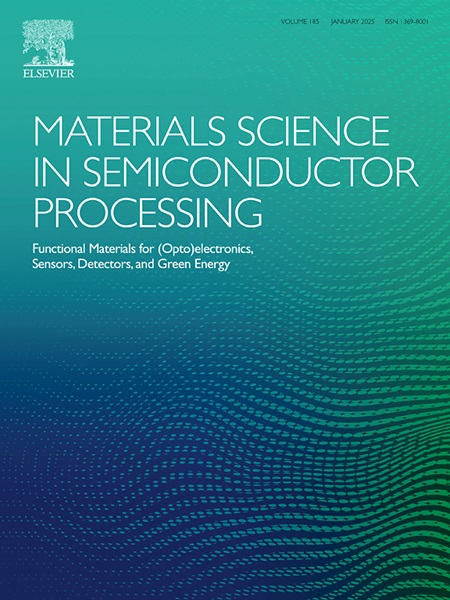Au/rGO修饰对先进等离子体染料敏化太阳能电池中垂直排列的TiO2纳米棒阵列的协同影响
IF 4.2
3区 工程技术
Q2 ENGINEERING, ELECTRICAL & ELECTRONIC
引用次数: 0
摘要
在追求提高染料敏化太阳能电池(DSSCs)性能的过程中,提高比表面积、电导率和有效的电荷分离是一个至关重要的因素。本研究探讨了金(Au)等离子体和还原氧化石墨烯(rGO)在TiO2纳米棒(NRs)中的整合,以提高DSSC的性能。采用水热法制备了由氧化石墨烯和金修饰的金红石相TiO2纳米杂化光阳极。XRD证实了四方金红石型TiO2纳米棒的形成,而拉曼光谱和x射线光电子能谱(XPS)证实了TiO2、rGO和Au之间的强相互作用,促进了有效的载流子转移,降低了复合速率。SEM辅助元素分析表明,一维TiO2纳米棒成功生长,平均长度为5.20 μm,直径为194 nm,并证实了还原氧化石墨烯和Au对纳米棒的有效修饰。紫外可见光谱表明,Au/rGO修饰后,吸收边向可见光区移动,带隙变窄,可见光响应被放大。然后,利用100 mW/cm2处理下的电流密度-电压图,研究了以装饰一维二氧化钛纳米棒作为光阳极、N719敏化剂、液态电解质和Pt对电极的DSSCs的载流子输运特性和性能。与纯TiO2 NR光阳极相比,Au/rGO修饰在TiO2 NR上增加了光电流产生[Jsc = 18.22 mA/cm2],光转换效率[η = 6.74%],并降低了Au/rGO@TiO2/染料/电解质界面处的电荷转移电阻[Rct = 8.50 Ω]。利用电化学阻抗谱分析了制备器件的电化学行为,并通过波德相图评估了纳米杂化光阳极中注入电子的寿命,发现其为25.23 ms。因此,rGO和Au的掺入分别增强了电导率和等离子体效应,从而带来了优越的光伏性能,这种创新的方法突出了利用先进纳米材料的协同效应提高DSSCs转换效率的潜力,从而为高性能、高效太阳能转换设备的发展铺平了道路。本文章由计算机程序翻译,如有差异,请以英文原文为准。
Synergistic impact of Au/rGO decoration on vertically aligned TiO2 nanorod arrays for advanced plasmonic dye-sensitized solar cells
In the pursuit of improving the performance of dye-sensitized solar cells (DSSCs), improving surface area, electrical conductivity and efficient charge separation has been a crucial factor. This study investigates the integration of gold (Au) plasmonics and reduced graphene oxide (rGO) into TiO2 nanorods (NRs) to advance DSSC performance. A nanohybrid photoanode comprising rutile phase TiO2 NRs decorated with both rGO and Au was synthesized via hydrothermal method followed by UV irradiation. XRD verified the development of tetragonal rutile TiO2 nanorods, while Raman and X-ray photoelectron spectroscopy (XPS) evidenced strong interactions among TiO2, rGO and Au, promoting effective charge carrier transfer and lowered recombination rate. SEM assisted elemental analysis inferred the successful growth of one dimensional TiO2 nanorods with an average length of 5.20 μm and 194 nm diameter and confirmed the effective decoration of nanorods with rGO and Au. UV–Visible spectra suggests that after Au/rGO decoration, the absorption edge shifts towards the visible area, the bandgap narrows and the visible light response is amplified. Then, the carrier transport properties and the performance of the DSSCs using decorated one-dimensional titanium dioxide nanorods as photoanodes, N719 sensitizer, liquid state electrolyte and Pt counter electrode have been examined utilizing current density-voltage plots attained at the treatment of 100 mW/cm2. In comparison to pure TiO2 NR photoanode, the decoration of Au/rGO onto TiO2 NRs increased the photocurrent generation [Jsc = 18.22 mA/cm2], photoconversion efficiency [η = 6.74 %] and lowered the charge transfer resistance [Rct = 8.50 Ω] at the Au/rGO@TiO2/dye/electrolyte interface. The electrochemical behaviour of the fabricated device has also been analysed using electrochemical impedance spectroscopy and the lifetime of the injected electrons in the nanohybrid photoanode, assessed from the Bode phase plot was found to be 25.23 ms. Thus, the incorporation of rGO and Au enhances the electrical conductivity and plasmonic effects, respectively, leading to superior photovoltaic performance and this innovative approach highlights the potential for enhancing the conversion efficiency of DSSCs by leveraging the synergistic effects of advanced nanomaterials, thereby paving the path for the progress of high performance, efficient solar energy conversion devices.
求助全文
通过发布文献求助,成功后即可免费获取论文全文。
去求助
来源期刊

Materials Science in Semiconductor Processing
工程技术-材料科学:综合
CiteScore
8.00
自引率
4.90%
发文量
780
审稿时长
42 days
期刊介绍:
Materials Science in Semiconductor Processing provides a unique forum for the discussion of novel processing, applications and theoretical studies of functional materials and devices for (opto)electronics, sensors, detectors, biotechnology and green energy.
Each issue will aim to provide a snapshot of current insights, new achievements, breakthroughs and future trends in such diverse fields as microelectronics, energy conversion and storage, communications, biotechnology, (photo)catalysis, nano- and thin-film technology, hybrid and composite materials, chemical processing, vapor-phase deposition, device fabrication, and modelling, which are the backbone of advanced semiconductor processing and applications.
Coverage will include: advanced lithography for submicron devices; etching and related topics; ion implantation; damage evolution and related issues; plasma and thermal CVD; rapid thermal processing; advanced metallization and interconnect schemes; thin dielectric layers, oxidation; sol-gel processing; chemical bath and (electro)chemical deposition; compound semiconductor processing; new non-oxide materials and their applications; (macro)molecular and hybrid materials; molecular dynamics, ab-initio methods, Monte Carlo, etc.; new materials and processes for discrete and integrated circuits; magnetic materials and spintronics; heterostructures and quantum devices; engineering of the electrical and optical properties of semiconductors; crystal growth mechanisms; reliability, defect density, intrinsic impurities and defects.
 求助内容:
求助内容: 应助结果提醒方式:
应助结果提醒方式:


